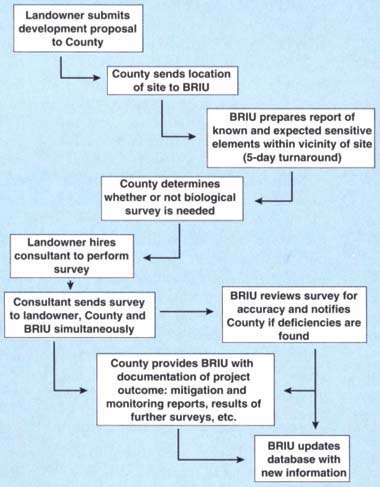All Issues
Sidebar: UCR's Biological Resources Information Unit: Local conservation planning backed by UC expertise
Publication Information
California Agriculture 49(6):55-55. https://doi.org/10.3733/ca.v049n06p55
Published November 01, 1995
PDF | Citation | Permissions
Abstract
Abstract Not Available – First paragraph follows: Riverside County is the site of some of the most expensive environmental conflicts nationwide, containing many rare and endangered species and a high rate of urban expansion. To help avoid these conflicts, a coalition of citizens, county officials and scientists sought to formalize the county's access to University of California expertise by creating the Biological Resources Information Unit (BRIU) in 1992.
Full text
Riverside County is the site of some of the most expensive environmental conflicts nationwide, containing many rare and endangered species and a high rate of urban expansion. To help avoid these conflicts, a coalition of citizens, county officials and scientists sought to formalize the county's access to University of California expertise by creating the Biological Resources Information Unit (BRIU) in 1992.
This unique partnership that is developing between county government and UC is a geographic information system that shows the locations of more than 400 of Riverside County's sensitive species and habitats. The BRIU information is collected from a variety of sources including environmental review documents, museum records and UC researchers. Similar regional databases, such as the California Natural Diversity Data Base, are neither as complete nor as local in scale.
The BRIU is intended to be an early part of the County Planning Department's environmental review process (see flowchart), but has many other applications as well. For example, the database could also be available to other land management agencies through cooperative agreements. The BRIU is part of UCR's Urban and Environmental Outreach Program, with funding provided by UCR's College of Natural and Agricultural Sciences, the Integrated Hardwood Range Management Program, and Renewable Resources Education Act funds. After start-up, the BRIU will be self-supporting through user fees and grants.
A development proposal submitted to the County will be forwarded to the BRIU, which will return a report of any sensitive species expected to be in the area along with other pertinent information such as the season of occurrence for each species. If the developer decides to proceed, the county may require him or her to hire a biological consultant for on-site surveys. Information from the surveys will be reviewed by the BRIU biologist for completeness and accuracy and then entered into the database. This step in the process serves two important functions: the database will be updated continually, and the County will get an outside “check” on the quality of biological information in the reports. In the case of questionable data, the County will have the option of requesting a full review from the Technical Advisory Committee to the BRIU (a panel of UC and non-UC biologists).
Flowchart for proposed incorporation of the Biological Resources Information Unit (BRIU) into Riverside County's environmental review process.
Proponents of the BRIU have been careful to enlist cooperation and input from a wide array of organizations and agencies (including government agencies, environmental groups, local developers and city representatives). Support for the project has been widespread, as the benefits are several:
-
Developers will be alerted to potential natural resource issues early in the review process, avoiding 11th-hour conflicts with environmental interests.
-
The BRIU will allow biological consultants to focus on data collection, interpretation and mitigation plans (rather than researching past observations) and more than likely will validate their results.
-
The environmental review process will be enhanced because better-quality biological assessments will lead to better-informed decisions. Regional conservation planning will also benefit from access to the database.
-
The County Planning Department will gain access to high-quality data and interpretation of the information by the BRIU biologist and other UC personnel.
The BRIU recently received a grant to create a similar database for San Bernardino County.





